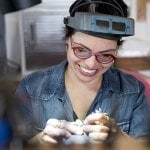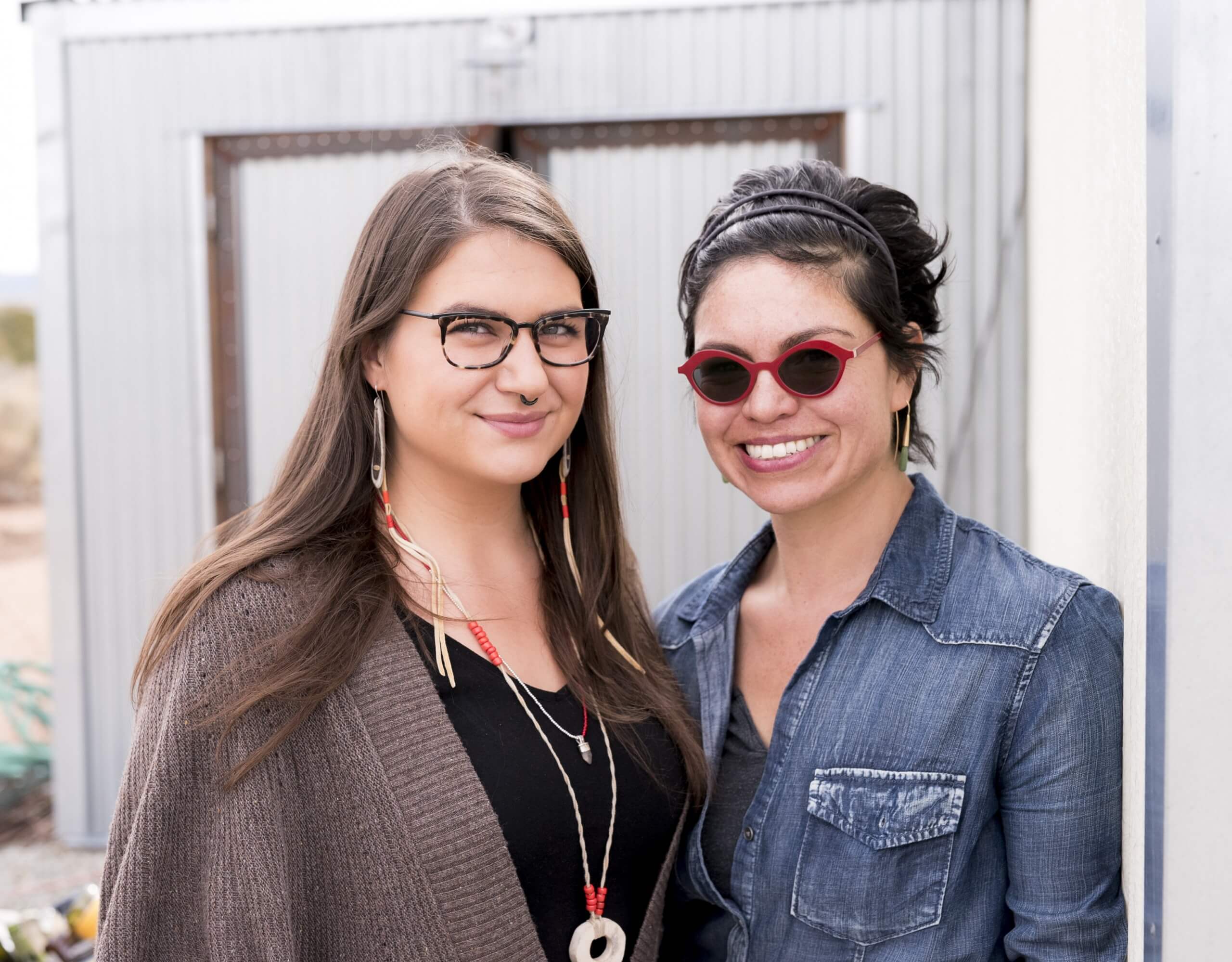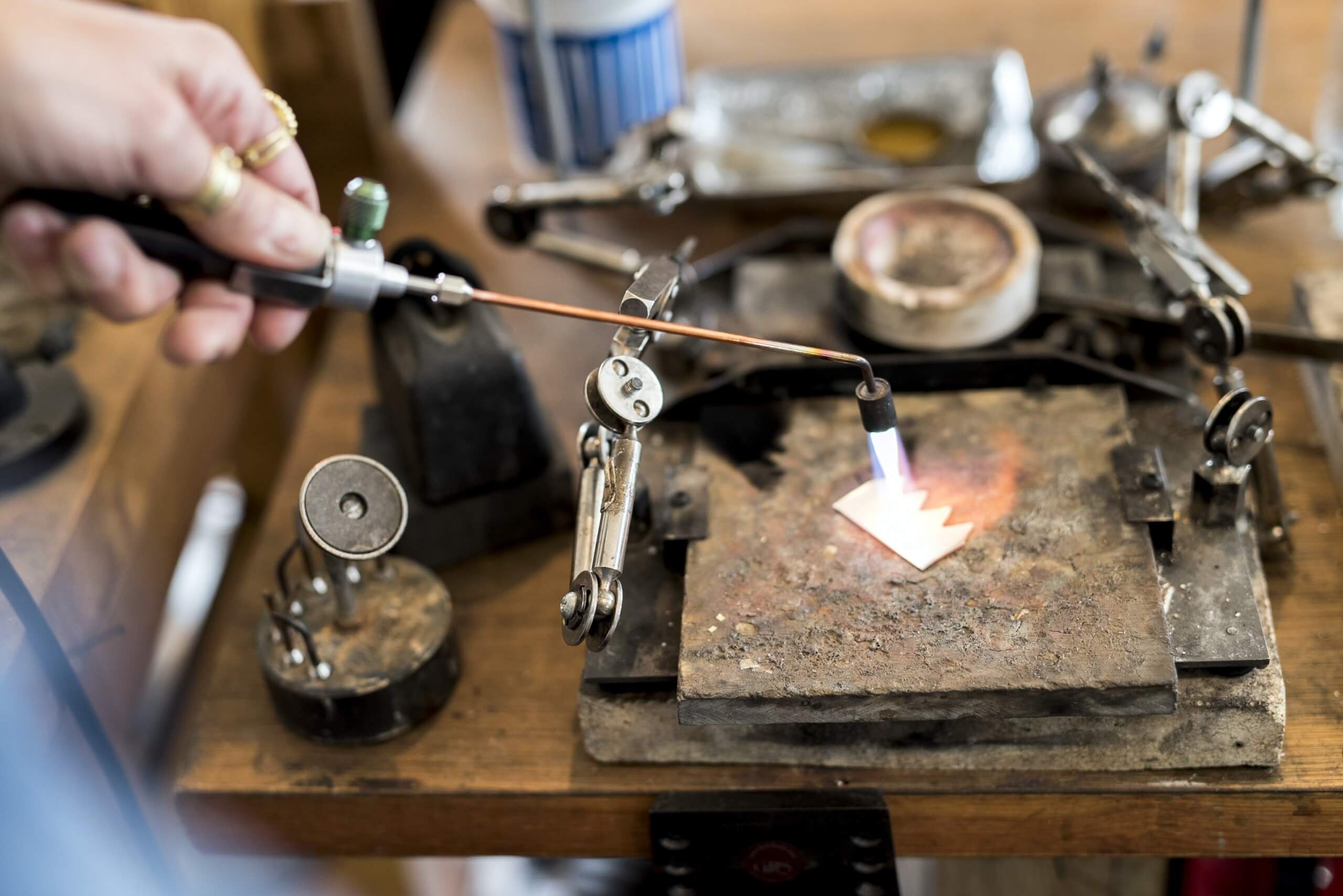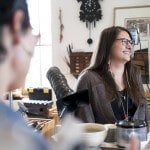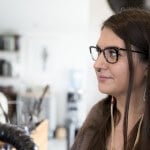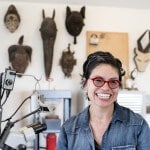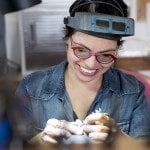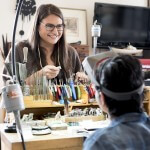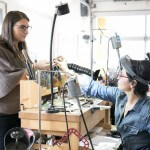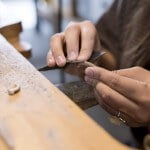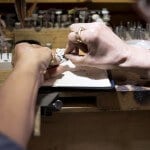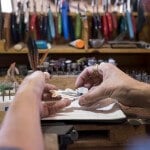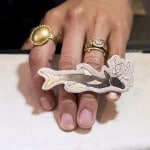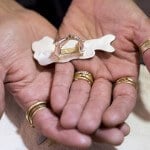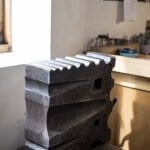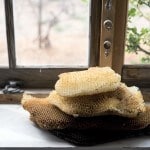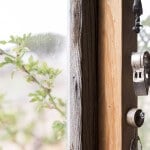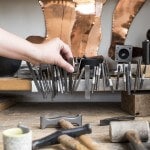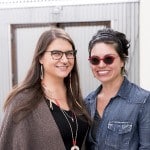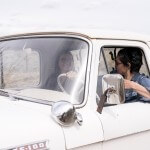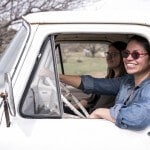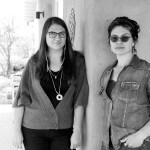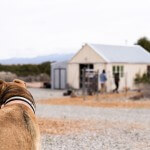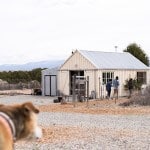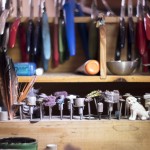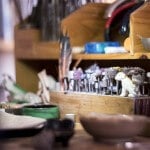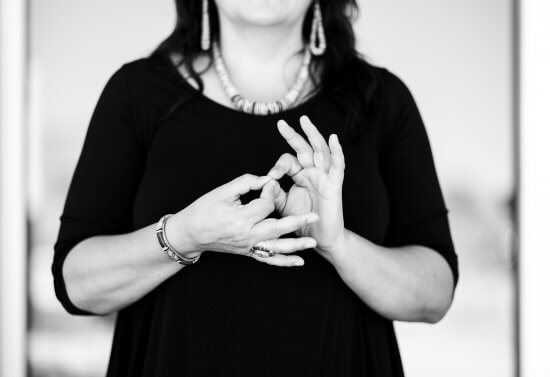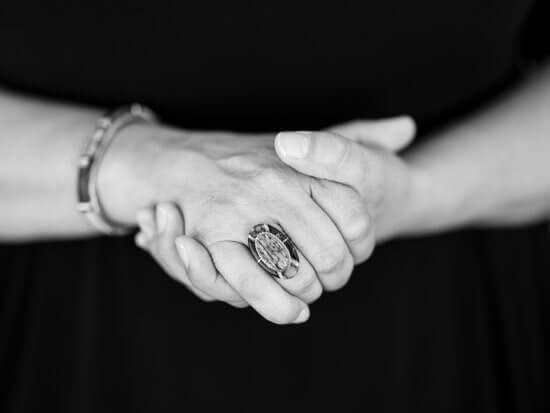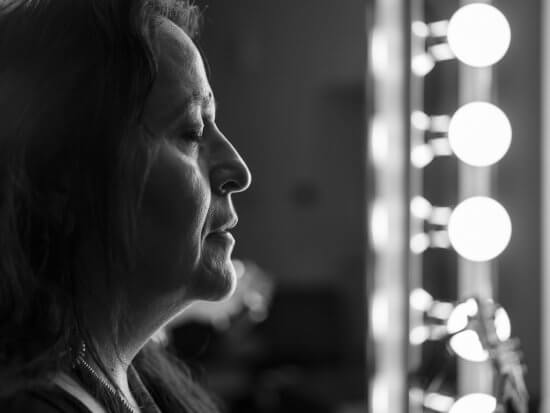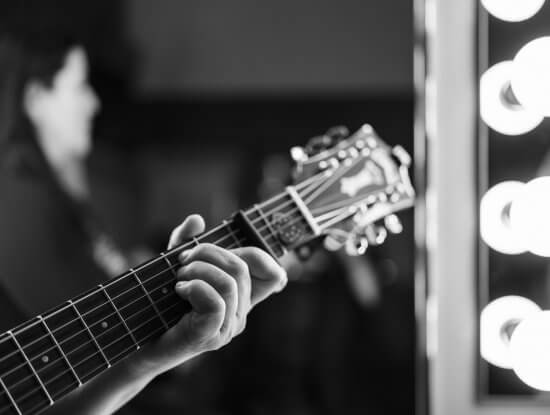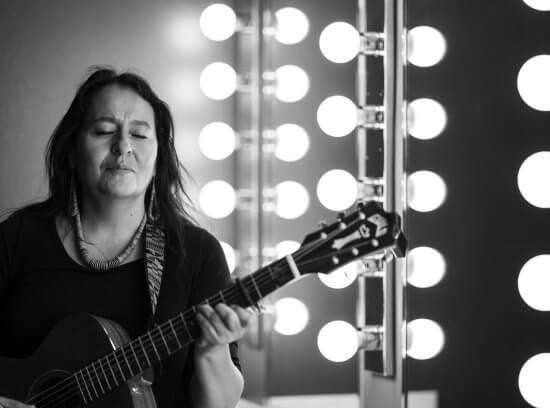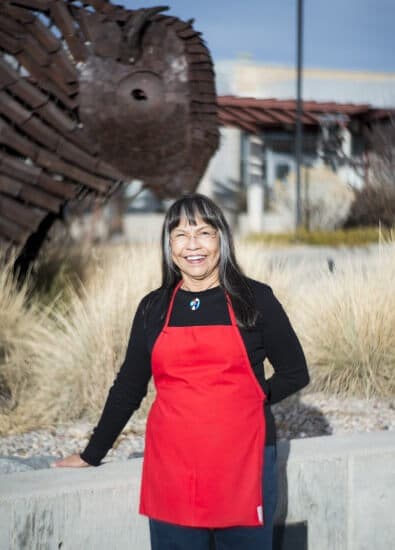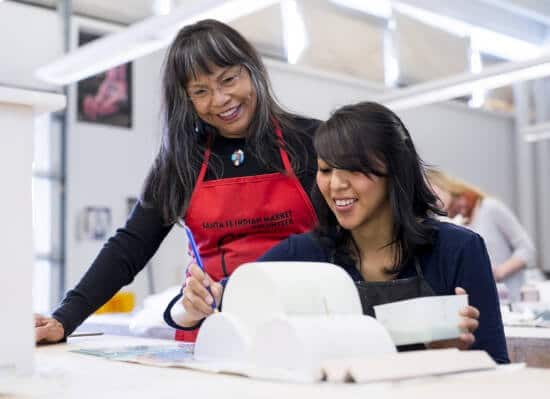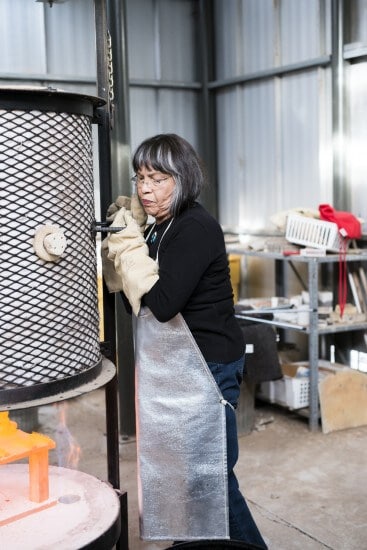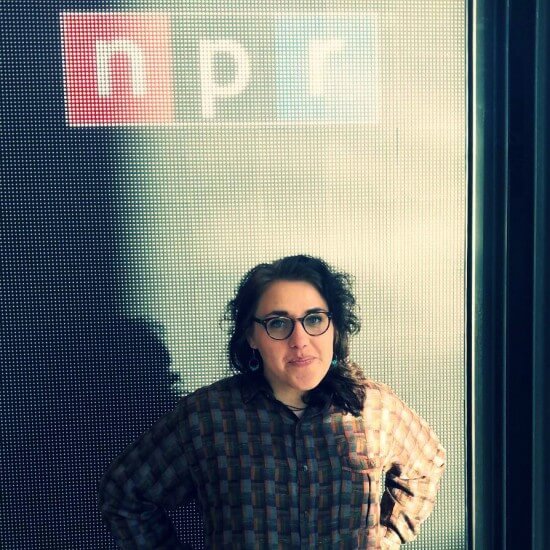Alumni Profiles
IAIA alumni are an important part of our extended family. Being an alumnus is to be part of an illustrious creative community. One of the best ways to tap into that community and make it stronger is to stay involved. It’s a chance to network, renew old friendships and start new ones.
Download digital versions of the IAIA Alumni Newsletter.
Keri Ataumbi (Kiowa) ’96
Teaching and Learning Jewelry with Keri Ataumbi ’96 and Tania Larsson ’17
It’s clear that Keri Ataumbi and Tania Larsson have a rapport. They smile and make each other laugh. But it’s also easy to feel comfortable on the homestead where Ataumbi (Kiowa) has a two-story home, a yard decorated with bright wood furniture and metal and stone sculptures, a garden out back, and an old unibody Chevy truck parked in front of her adobe-walled studio that sits away from her house. She even keeps bee hives for honey. Everything on her Galisteo Basin property looks like a painting or photo-op. Inside her studio you can see her appreciation of art—on the walls are black and white nudes, African masks, a plains headdress, and a stunning photo by Cara Romero (Chemehuevi) ’06 of two figures dressed in pueblo dance regalia, holding juniper sprigs, falling backwards into a green ocean.
It’s in this setting that Ataumbi, 44, spends most of her time, and where Larsson (Gwich’in), 26, joined her as an apprentice on Fridays and Saturdays in the 2016 spring semester. They start their days at 7:30am, doing the “dirty jobs” of checking email, invoicing orders, and cleaning the studio, then get down to jewelry and work until 6pm. One of Ataumbi’s main lessons is the work habits of a professional artist.
“It’s very easy when you’re by yourself to procrastinate,” Ataumbi says. “To be successful you have to work every day. So we’re trying to establish work habits, things that you get outside the classroom.”
Larsson has taken these lessons in stride. She relishes the freedom to pursue her personal jewelry projects but at the same time have the guidance of an expert whenever she wants it.
“I’m learning how to become a professional artist, to follow my own ideas,” Larsson says. “This mentorship has been a game-changer for me and my work. I’ve been able to work with gold, with diamonds, with a laser welder. We go over all steps of the design process from design to marketing.”
Their student-mentor relationship has also become a friendship. Larsson says a big part of what she loves about the mentorship is seeing other aspects of Ataumbi’s life outside of jewelry that keep her well-rounded. Ataumbi has shown Larsson how to garden, harvest honey from her bee farm, and they have gone to local pueblo dances to meet with Ataumbi’s artist friends.
Ataumbi grew up in the Wind River reservation in Wyoming, the daughter of a Kiowa mother and Italian American father. She went to boarding school in Boston, then took classes at the Rhode Island School of Design before attending IAIA in the mid-1990s. Quite a different upbringing than Larsson, who grew up in France the daughter of a Gwich’in mother and Swedish father. Larsson has since returned to her family homeland in Yellowknife, Canada. She now calls the Northwest Territories home and it’s where she engages in cultural revitalization through activities like traditional moose hide tanning.
Ataumbi taught a jewelry class at IAIA in 2014 and it was there that Larsson first studied with her. Larsson knew right off that she wanted to learn more.
“Tania wasn’t scared of me in class,” Ataumbi says with a smile. “I’m past 40 and I’m a Kiowa woman. That scares some people.”
In addition to the practical work and life experience, Larsson earns class credit towards her studio art degree with the mentorship. She plans to graduate with a BFA in 2017.
Recently, Larsson was named a SITE Santa Fe Scholar, an award that recognizes a select group of art students in Santa Fe for their excellence. Ataumbi attended the reception, where she saw Larsson’s mixed-media piece that is contained in a sculpted wooden box requiring the viewer to look into it like you would an old standing camera. Inside the box, a video of Larsson tanning hide is projected past a moose hide and dentalium shell necklace. Combined with the sound of Larsson’s hide scraping that comes through a pair of headphones, the experience is meditative as well as beautiful.
“I was beaming with pride,” Ataumbi says. “I really do feel like I’ve learned as much from Tania as she has from me.”
Photographic Selections from the Interview
Tash Terry (Navajo) ’91
We are the Music
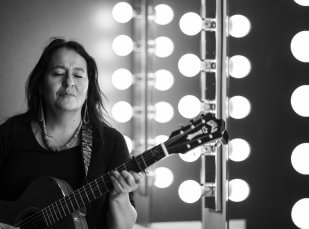
Tash Terry sings her song “Grandmother Earth, Grandfather Sky” in the Green Room of the IAIA Performing Arts Center
Tash Terry ’91 sings in Navajo. In “Grandmother Earth, Grandfather Sky,” she sings of her grandmother, one of the key influences in her life. She accompanies herself on guitar, the best instrument, she says, for writing songs. The tune makes you want to nod your head, tap your feet. She bridges the lyrics with the Navajo vocables way-nah, hey-ney. She sings about the stories she’s heard and remembered, the Navajo way of living with the land, living a spiritual life. Terry, 50, is a musician, writer, playwright, activist, and community organizer.
She is also a certified sign language interpreter for the deaf and hard of hearing. She learned to sign from a Navajo woman from Tsaile, Arizona, on the Navajo Nation where Terry grew up. As she talks, her hands sometimes accentuate what she’s saying, naturally making the sign for a word or phrase. Terry befriended the woman, Arletta, one summer when she was 11. Arletta’s deaf husband came looking to buy Terry’s family’s broken down Volkswagen bug that he’d seen in the yard. She recalls being startled when he tried to sign to her and then stepping back when he tried to talk to her. “I was scared of the sounds coming out of his mouth.” He had his two sons with him, bi-racial like Terry was, with a Navajo mother and white father. She was struck by these little boys who had their hair in traditional tsiiyéél buns and spoke to each other in Navajo. They were “codas” or children of deaf adults. Fascinated by this new world, Terry set out to find Arletta. What she found opened her eyes.
“When I met them, then I had a life,” Terry says. It was a whole new way of being. She spent much of her free time learning sign language from Arletta.
“There wasn’t much to do in Tsaile in the summertime,” Terry says. It was also a way to get away from the alcoholism and resulting violence that could flare up unexpectedly in her home. She found purpose with Arletta and her sons. “I fell in love with that family,” she says.
But there was also heartbreak in the deaf world—and injustice. Arletta’s mother was a hand-trembler medicine woman. “And I assumed she was taught the traditional teachings,” Terry remembers. “But because she was deaf, she wasn’t. Nobody taught it to her. Can you imagine? Being in the sweatlodge, in that blackness and heat with no way to hear or understand what’s happening and why? No one told her. No one. Nothing about the hozhóójígo [Beauty Way ceremony]. Nothing. That is unconscionable.”
Terry is bi-racial, born to a Diné mother and white American father. She says how this heritage informed so much of her young life, and how she had conflicting feelings about her white heritage, especially growing up in the Navajo Nation where sometimes people would snicker when she introduced herself as “Bilagáana báshíshchíín,” “born for the white people.”
“I was shameful of being half white,” Terry says. “I was shattered. There’s something that happens in a young person’s mind when their elders laugh at them, when people ridicule them.”
It was a complex, conflicted history that made some people react that way, Terry learned later, a history of oppression, violence, pain.
But she found solace on her family’s sheep camp in Black Mesa, Arizona.
“There was protection up there,” Terry says, “with the elders who all spoke Navajo. It was really good, hard living. There was no running water, no electricity. I have a lot of good memories from that place and time. Walking to the outhouse at night with my grandma so the skinwalkers wouldn’t get me. Taking care of the sheep, taking them through the sheep dip, carding wool. Every day was all about the livestock, all about the seeds, the corn coming out of the ground.”
In 1987, at 19 years old, she found the courage to come to IAIA and pursue an artistic education. All she’d known up to that point was the Navajo setting, culture, and environment, one that didn’t trust non-Navajo or white people and places.
“I felt like one of the kids from the late 1800s taken to boarding school,” Terry says. “I had learned to hate the colonizers, to hate the government. So when I left the [Navajo] four Sacred Mountains and came to Santa Fe, I was like this—” and here she puts her hands out as if to ward someone off.
So getting her AFA at IAIA was about struggling to find her identity, wrestling with things inside herself as well as a new world. Being at IAIA and living on her own in Santa Fe opened her eyes and Terry was able to explore. After an interlude in which she went home to Chinle and taught at a local school as an acting speech therapist, she returned to IAIA and finished her degree in creative writing in 1991.
“I’ve always had stories in my head,” Terry says. So much so that she was known to go off into the woods with a notebook, sit on a rock and write. She produced her first play in high school, called “The Impossible.” It was about Janis Joplin, Jimi Hendrix, Elvis Presley, and Marilyn Monroe coming together for a battle of the bands. It ends when they go their tragic separate paths of substance abuse. Already Terry was dealing with the heavy issues she saw around her.
After her degree, Terry spent the next few years working at restaurants around town and learning music and playing in bands.
Photographic Views
Terry eventually gravitated back to the world of the deaf and hard of hearing, and wanted to go into sign language interpreting. But to be a professional interpreter, she had to have a bachelor’s degree. So she returned to IAIA again, this time to get her BFA. She received her BFA in 2007 and went on to get her interpreter’s certificate in American Sign Language. She also used the post-graduation time to tour with her music, having formed the duo Indigie Femme with her Maori partner Elena Higgins. It was during this time of touring that Terry visited her Anglo relatives in upstate New York where she learned that they were admirable people, too. She was able to come to terms with her own heritage, to make peace with the sides that seemed to be at war inside her. But not until she had done one more thing. “I went to where they were buried and I cussed out my grandparents. Then I made peace. Then I said prayers. And it was funny, after I’d had my ceremony, I felt a weight off my shoulders. And when I was out and performing I would feel good introducing myself with both my Navajo and white sides.
“Now I come from a place of love when I sing my songs and speak out,” Terry says. “Not a place of hate. That is the way I apply the Diné Hozhó ideals, how I try to ‘walk in beauty.’”
Terry says she wants to share what she’s learned on her journey with young Native musicians and artists, that it’s possible to let go of the inner conflict, and to be a better person and artist because of it.
Her musical career has taken off since her graduation in 2007. Indigie Femme now boasts eight music awards, eight albums, and tours locally as well as internationally. Terry also cofounded the non-profit Indigenous Solutions with Higgins, which will be presenting the inaugural Indigenous Solutions festival in Chinle, Arizona, on August 11. They’ll bring Navajo and other Native musicians, comedians, and performers for a day of civic-minded entertainment. Terry is particularly proud that the festival will be accessible to the deaf and hard of hearing through a team of American Sign Language interpreters.
Terry also works at IAIA as a sign language interpreter and can be seen on stage at events like the IAIA Commencement, wearing simple black clothing, her hands free of jewelry and any visual other visual distractions, signing.
She has come back to IAIA as a student for a third time, this time for an MFA in creative writing. “I’m now at a place in my life where I want to write,” she says, “about cross cultural exchange, about living in different moccasins, conflict, disaster, recovery.”
“It brings me to tears on that [IAIA] campus when I’m interpreting for students,” Terry says. “I get nostalgic. I look at their faces and I see myself from 30 years ago and I wonder where they’re at with their identities.”
Does she wish she was young again?
“No,” she says. “I was in crisis back then. Now I’m having a good time.” And here she smiles. “Now I sing about love.”
Her song about her grandmother ends with a Navajo refrain: Nahasdzáán nihimá/Yádihil nihizhé’é danihilí, “We are our mother, the earth/We are our father, the sky.”
Karita Coffey (Comanche) ’65
Karita Coffey ’65 retires after over 25 years of teaching at IAIA
You know you’re on the right track when you can get Karita Coffey to laugh. When she laughs you’re let into her world a little at a time, to what she holds dear, to the reasons why she teaches, to why she is an artist. Each laugh opens up a window into what drives her. You can tell she loves to laugh—her whole face breaks open into a smile when she tells a joke. And sometimes, if you’re lucky, she will place her palms to her cheeks in the middle of her laugh and tilt her head just so and she could be 16 again at the old IAIA campus on Cerrillos Road, just starting out on her path to being an artist.
In 1963 when she was 16, Coffey (Comanche) moved from Lawton, Oklahoma, to Santa Fe and attended IAIA when it was still an arts high school. She knew in her first IAIA ceramics class that she wanted to work with clay the rest of her life.
“It was like love at first touch,” she says. “I really liked clay. I liked the way it felt. I still like the way it feels.”
But the roots for her life as an artist started even earlier. When she was 12, a Comanche elder gave her the name Tsat-Tah Mo-oh Kahn, or Good-Handed.
“You could almost say it was destiny,” Coffey says, smiling.
In May 2015, Coffey, who is 68, retired after twenty-five years of teaching at IAIA. She is well known for her excellent classes and rigorous teaching style, always encouraging her students to push the envelope with their art. In 2012, IAIA students voted Coffey Faculty of the Year, and in 2015 she received the Honored Educator Award from the renowned art organization SITE Santa Fe.
Coffey says the act of creating is what has always inspired her. “I’m more whole when I’m doing work and making art,” she says. “We glow when we’re really immersed like that.”
In turn, her teaching approach has always been to emphasize the creative process with her students. “I teach students that the point isn’t so much the end product but how you feel when you create.”
Coffey’s own work displays the full range of her skills as a ceramicist, sculptor, and metalsmith. While she admits resisting metalwork, saying the material is “too hard, too inflexible,” Coffey has been incorporating wax-cast metals into her art for years now. Coffey’s teaching style mirrors the way she works on her own art. When she pushes her own students to work conceptually, to incorporate metaphors into their work, it’s because she strives to do the same.
In some of her recent work, Coffey took on the subject of violence against children and used the iconography of dolls in small-scale works of ceramic, wood, and cast metals. One piece, “Just a Plaything,” is a toy, but it’s unlike any toy you’ve ever seen. A doll’s head of carved and fired ceramic accentuated with glazes rides atop two model car wheels and the face is attached to a cocoon-shaped body, also ceramic. On top of this body is a small cast-silver faucet knob, much like one you would find connecting a garden hose to a house. It’s obvious that a keen and creative mind is at work: there is an artist here, the piece seems to say. The object is beautiful, but also unsettling in the way the soft face contrasts with the wheels, like a wild animal, at once beautiful and dangerous when you look it in the eye.
Coffey says she was trying to show how helpless children can be in the world of adults. She has created a series of these toy-like sculptures, each one involving the same mix of media, from found objects to worked ceramic to cast metals, and all with the same attention to detail. These pieces are the work of a master artist. But they might not be the first pieces a casual art collector might reach for. Coffey admits with a wry smile that “they don’t sell,” but she continues to make the art nonetheless. She seems driven to make them. Given her advice to students, Coffey can’t exactly back down when facing the challenges of making her own art. Working on a recent project, it took her 27 hours to carve a doll’s head out of wax to cast into metal. She had doubts she could finish it, but she pressed on.
“I could go without sleep when I was working on these pieces,” Coffey says. “I’d get so immersed, I’d go to the grocery store and it was all I was thinking about. I dreamed about it. It’s because the artwork is so much a part of you.”
Other artists have also taken notice of Coffey’s art and teaching. Jon Davis, director of the IAIA MFA in Creative Writing, and himself a 25-year teacher at IAIA, has noticed how close Coffey holds her own work.
“Karita has always been a little reticent about showing her work, which is a quality I admire,” Davis says. “I always got the impression that making the work was the important thing. Showing it was secondary. I remember when I first saw the pieces she made investigating childhood. They exceeded their physical dimensions and their craft. They seemed endowed with time and depth and mystery.”
Laura Walkingstick ’14, an IAIA alumna and student of Coffey’s, has won acclaim in her own right recently for her ceramic dolls, and was named a SITE Santa Fe Scholar in 2013. It was Coffey’s teaching that spurred Walkingstick to take her art to the next level.
“She taught me a different way of looking at art,” Walkingstick says. “Instead of just saying a piece looks good, [Coffey] encourages you to think about it longer, to let it rest and go to work in your mind. She taught us that there’s always something more to say about a piece—you want the audience not to walk away; you want them to wonder.”
For Walkingstick, Coffey’s classes were the turning point in her time at IAIA: “She went beyond what she had to, and that was probably why my work in my senior year was so good. She made me think further and push my work like I never had before.”
“To me that’s the fun part,” Coffey says. “I see it happen. I see it happen. I see them blossom. I see them take risks and that’s what fulfills me as a teacher. I get energy from that.”
This leads Coffey into reflection about her chosen profession. “What other rewards are there as a teacher except when you see they get it,” she says. “That’s what matters. Because when they get it, it lasts. I know what it feels like to get it, too. Teaching is a calling, the same as being an artist is a calling.”
What’s next for Coffey? She says she’ll spend more time with her family, with her daughter in Lawton, Oklahoma, and more time making her own art.
“At a certain point,” Coffey admits, “you need concentrated time to do art regularly. You have to be consistent or else you’ll lose your momentum and outgrow your ideas—you go too long and it’s gone.”
Retiring from teaching will give her that time. “I’ve been lifting fifty-pound boxes of clay in the studios for years. Enough.” She pauses, and with a smile that will turn into her signature laugh, says, “I want to lift my own clay now.”
Christine Trudeau (Prairie Band Potawatomi) ’14
Journalism takes Christine Trudeau ’14 from IAIA to NPR
Christine Trudeau (Prairie Band Potawatomi) is a freelance journalist, producing and writing stories for Native Peoples Magazine, National Native News and the Santa Fe New Mexican. Her most recent position was at National Public Radio in Washington, DC, where she began as an intern and later was hired as staff in the company’s diversity department. She has since been accepted to Columbia University’s Graduate School of Journalism, where she began work on a master’s degree in the fall of 2015. Here, the 30-year-old creative writing major talks about mainstream media and what she learned at IAIA.
How has your time at IAIA influenced your current work?
My initial goal when I came to IAIA was to tell stories and study creative writing. Then I realized there was an option to do journalism. I love both news and creative writing—writing is still writing. Story writing is a big part of who I am now, and I was exposed to that at many levels at IAIA. I learned there are different ways of storytelling. At IAIA I was taught to read all kinds of things from novels to short stories to essays. I was able to explore different genres of writing and see the long view of writing as a career.
I studied with Tristan Ahtone [2007 IAIA alum], who was my Journalism 1 professor. He helped me get an internship at KUNM in Albuquerque and that was a big step for me toward a national media platform. KUNM was my introduction to a newsroom—I learned how to write for deadlines and create good working habits for a radio program.
What was your experience like working at NPR?
It was amazing. Growing up I didn’t have TV and so I listened to a lot of radio and NPR. To see [NPR radio hosts] Scott Simon and Robert Siegel in the elevator—these voices I had heard so often on the radio—was surreal. At first I was shy and didn’t know how to talk to people. NPR has a massive building with so many people working there and such a tremendous history of news. As one of the younger employees, I felt like part of a new voice coming up at NPR and it was exciting.
NPR taught me to become quicker at communicating my ideas because you have such a quick turnaround for the work you do. In journalism it helps to be sharp and concise in communicating—so it’s best when you can cut away the excess material.
What was it like being Native American in Washington, DC?
In this mainstream environment you have to be ready to be the only Native person in the room. You have to say, “This is my voice as a Native person and this is what I say.” It’s scary. It’s a lot of work to be the only Native person in a room of non-Native people. But I get a lot of support from my family and my mentors.
What advice do you have for aspiring journalists?
Always ask for help. Make it a habit, even if you’re not used to it. You’re already ahead of the game if you’re asking for help. Find your resources at IAIA. IAIA made journalism possible for me. Opportunities are out there. Be open to talking to people who don’t know anything about Native people. It’s worth it. It’s worth having a voice out there. As a Native person you can cover news in ways non-Natives can’t—you have a totally different understanding of story and community. If anything, we’re more natural-born journalists than anyone else out there. We really take time to consider all sides to a story, and that doesn’t come as readily to other people. That’s another good thing about learning journalism at a Native school.
